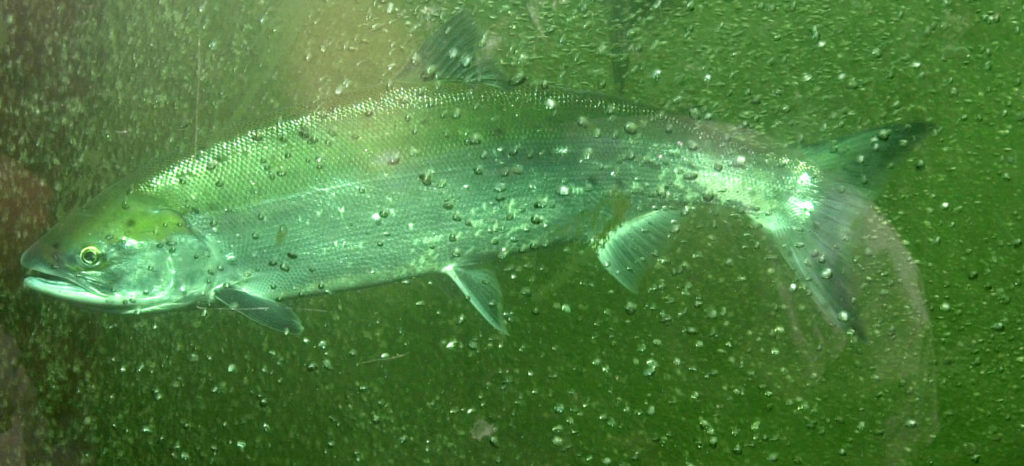Coming Home

Salmon leap and salmon twist
You feel the call that can’t be missed
We’re waiting here to welcome you back home
In your feeding grounds you hunt and play
Leave the deep green sea and come away
Leave the deep green sea and come away
Chorus: Coming home
Where the cliffs rise up in columns to the clear blue desert sky
The rivers foam
Where the banks are scented sagebrush and the dust blows alkali
Salmon leap and salmon twist
You feel the call that can’t be missed
We’re waiting here to welcome you back home
The sea is rich and the sea is full
But you answer the call of the river’s pull
You answer the call of the river’s pull
Chorus
Caliche soil and volcanic stone
The water carries the smell of home
The water carries the smell of home
Chorus
(Repeat: ) We’re waiting here to welcome you back home
Notes
The line ‘We’re waiting here to welcome you back home’ was inspired not only by Native American ceremonies to welcome the return of the salmon, but by the commercial and sport fisheries that depend on salmon, and the many groups that are working together to restore salmon habitat.
Mary Garvey asked me to write a song about salmon in Eastern Washington for her compilation CD, “Salmon – Fall Run”, released in Fall 2015. This is a companion to her other compilation CD, “Salmon – Spring Run”, which was released in Spring 2015. Both CDs contain songs about salmon performed by many Northwest musicians and songwriters.
Here’s how public opinion affected just one stream in Eastern Washington:
From a 2004 article in the Columbia Basin Herald, in which Washington State Potato Commission executive director Pat Boss responds to a proposal to stock lower Crab Creek with salmon. “We have some concerns about stocking Crab Creek with salmon……….We think that that could open up a whole can of worms if Crab Creek, which has traditionally been more of a creek or irrigation-type of channel, be made into some sort of salmon habitat………..A lot of people will say, ‘Well, we need to protect the salmon, we need to have enough water in the creek for the salmon,'” Boss said. “Our point is, there was never any salmon in that creek to begin with. Let’s not create an issue here and have salmon put in the creek, which all of a sudden restricts use of the creek, restricts use of the water, everything else.”
In the same article, Linda Jones of the Grant County PUD said one of the options was the possibility of putting a barrier at the mouth of Crab Creek to block out the migration of anadromous fish.
In 2007, the U.S. Bureau of Reclamation and the State of Washington proposed damming Lower Crab Creek for irrigation water to substitute for some of the many irrigation wells which are depleting the aquifer of the Columbia Basin. The proposed dam would have cost 3 billion dollars and would have flooded 25,000 acres, including 8,600 acres of farmland and a large portion of the 19,000 acres of state and federal wildlife refuges located there.
In 2008, after an onslaught of public concern about impacts to fish, migrating sandhill crane populations, public recreation trails, and private property, the government agencies backed down on the plan to dam Crab Creek and decided to pursue the study of a reservoir elsewhere.
As a result of the proposals to dam Crab Creek or to put up a barrier to block out migrating fish, the state Fish & Wildlife Department spent three years studying fish in Lower Crab Creek: “Although the creek was thought to be unsuitable for salmonids the project was to focus on habitat and water quality and to verify the presence of steelhead trout that had been previously reported in LCC. Secondarily, the project was to assess Chinook salmon that had been observed in LCC but were thought to be strays.”
In 2010, the Washington Department of Fish & Wildlife published the results of the study. To their surprise, they found that the salmon were not ‘strays’ but had always spawned there, even before the coming of irrigation in the 1950s affected the water flow. Despite the desert habitat and hot summer water temperatures that are lethal to fish, “The data suggest that a genetically distinct, native population of Chinook salmon inhabits LCC that has adapted to the rigorous environment.”
“The creek was thought to be unsuitable for salmonids, yet fall-run Chinook salmon Oncorhynchus tshawytscha spawn and rear in it. We used genetic analyses to examine the hypotheses that these fish are (1) random strays, (2) a population founded since the 1950s (by wild or hatchery strays), or (3) an established native population……The LCC population of Chinook salmon was found to be significantly different from interior Columbia River basin hatchery and wild populations and to have alleles that are absent from proximal populations. Lower Crab Creek Chinook salmon showed no evidence of recent founding and had genetic diversity, allelic richness, and effective population size similar to those of other Columbia River Basin Chinook salmon.”
Public concern for the environment had protected a population of salmon that scientists hadn’t previously realized was there, a variety of extra-tough salmon that has adapted to spawn in a warm desert stream.
Credits
- Written by: Alice Winship
- Arranged by: Lynn Applegate
- Lynn Applegate: lead vocal, guitar
- Bob Jackson: banjo, harmony vocal
- Dan Roberts: mandolin, harmony vocal
- Alex Sturbaum: guitar
